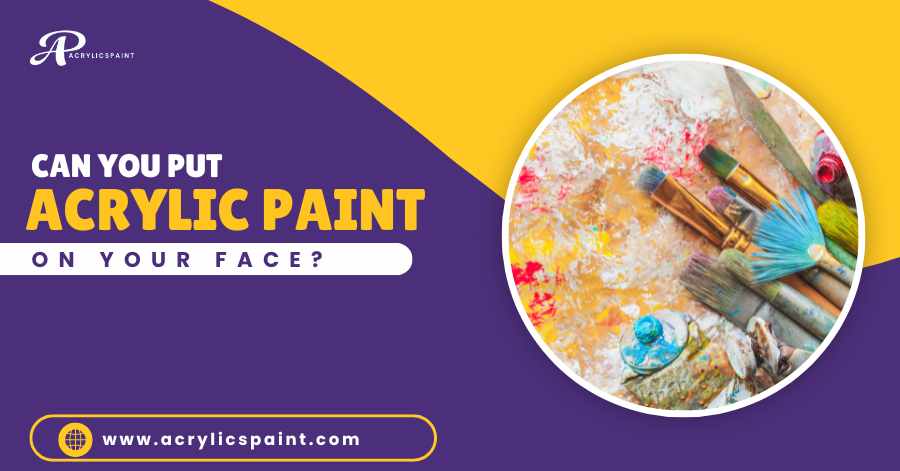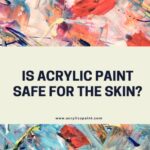Can you put acrylic paint on your face? The allure of vibrant face paint is worth pursuing. You can create fantastical creatures or sport festive looks for special occasions using acrylic paint. But with the vast array of paints available, a crucial question arises: Can you put acrylic paint on your face? While the idea might seem tempting due to its affordable price, the answer is a resounding no.
Is Acrylic Paint Toxic?
Acrylic paint is primarily made of pigment suspended in acrylic polymer emulsion, making it water-based and generally safe for artistic use. However, certain pigments may contain toxins, so checking labels for safety information is crucial.
Although acrylic paints are often labeled as “non-toxic,” they are not formulated for the delicate skin on our faces. Here’s what makes them unsuitable:
Potential Allergic Reactions
Acrylic paints contain pigments and binders that can trigger allergic reactions in some individuals. These reactions can range from mild irritation to severe rashes and inflammation.
Skin Irritation
Even without an allergic reaction, the harsh chemicals in acrylic paint can irritate the skin, causing dryness, redness, and discomfort.
Clogged Pores
Acrylic paint is not breathable and can clog pores, leading to breakouts and blemishes.
Difficult Removal
Removing acrylic paint from the face can be challenging, often requiring harsh scrubbing, further damaging the skin.

Is Acrylic Paint Safe for Skin?
While acrylic paint is formulated for use on surfaces like canvas, wood, and paper, its safety for skin application varies. Some acrylic paints are labeled as non-toxic and safe for skin contact, but not all are suitable for prolonged use on the face or other sensitive areas.
Can You Use Acrylic Paint on Skin?
You can use acrylic paint on your skin, but caution is advised. Ensure the paint is labeled safe for skin contact and perform a patch test before applying it to larger areas. Consider using skin-safe acrylic paint or those specifically designed for body painting.
Paints you Should Avoid using on the skin at any cost
Here are some paint colors you should avoid using on your skin at any cost:
Watercolor Paints
These are designed for paper and contain binders that can irritate the skin. They are also not water-resistant, making them impractical for face painting.
Tempera Paints
While sometimes used in artistic settings, tempera paints often contain ingredients like egg yolk or casein, which can trigger allergic reactions and irritate the skin.
Fabric Paints
These paints are formulated for fabrics and may contain harsh chemicals that are unsafe for skin contact.
Household Paints
Paints intended for walls, furniture, or other household surfaces are off-limits for skin application. They contain a multitude of harmful chemicals that can cause severe skin reactions.
Glitter that is not cosmetic-grade
Glitter designed for face and body art is safe, but avoid using craft glitter or any type not labelled for cosmetic use. These can have sharp edges and irritate the skin, especially around the eyes.
Remember, your skin is your body’s largest organ and deserves the utmost care. Always prioritize safety and never use paints not explicitly designed for skin application. Opt for safe alternatives like water-based face paints, skin-safe body paints, or non-allergic face paints for a fun and risk-free face painting experience.
Exploring Alternatives and Best Practices
What Paints Are Safe for Skin?
When it comes to body painting or face art, opt for paints explicitly labelled as safe for skin use. This includes water-based face paints, skin-safe acrylics, and FDA-compliant body paints. These formulations are formulated with non-toxic ingredients and are less likely to cause adverse reactions.
Best Face Paint Options
For those looking for the best face paint, consider brands known for their safety and quality. Look for dermatologist-tested products that are hypoallergenic and free from common allergens. Some popular face paint brands include Snazaroo, Mehron, and Wolfe FX.
Here are some more popular brands known for their safe face and body paints:
- Fusion Body Art
- Superstar Face and Body Paints
- Diamond FX
- TAG Body Art
- Paradise / Mehron Face Paints
- Global Body Art
- Cameleon
How Long Does Face Paint Last on Your Face?
The longevity of face paint depends on various factors such as skin type, application technique, and environmental conditions. Generally, water-based face paints can last anywhere from a few hours to a day with proper care and setting techniques like powdering or sealing with a setting spray.
Can you put acrylic paint on your face?
Acrylic paint can adhere to the skin, but not all acrylic paints are suitable for body painting. Avoid using acrylics meant for canvas or other surfaces, as they may contain harmful chemicals or have a texture unsuitable for skin application.
Is Acrylic Paint Bad for Skin?
While acrylic paint is not inherently bad for the skin, certain additives or pigments may cause irritation or allergic reactions. Always read labels and perform patch tests to ensure the paint is compatible with your skin.
Best Practices for Using Acrylic Paint on the Body
When using acrylic paint for body art, prioritize safety by choosing paints labeled safe for skin or body painting. Apply thin layers, allow adequate drying time between coats, and remove paint promptly after use to prevent skin irritation or clogged pores.
Conclusion
Can you put acrylic paint on your face? Using acrylic paint for face and body art is a great option, but safety should always be a top priority. You are choosing paints specifically formulated for skin use. Opt for best practices to unleash your creativity without compromising your well-being. So go ahead and paint your masterpiece, but remember to prioritize your skin’s health and safety every step of the way.














